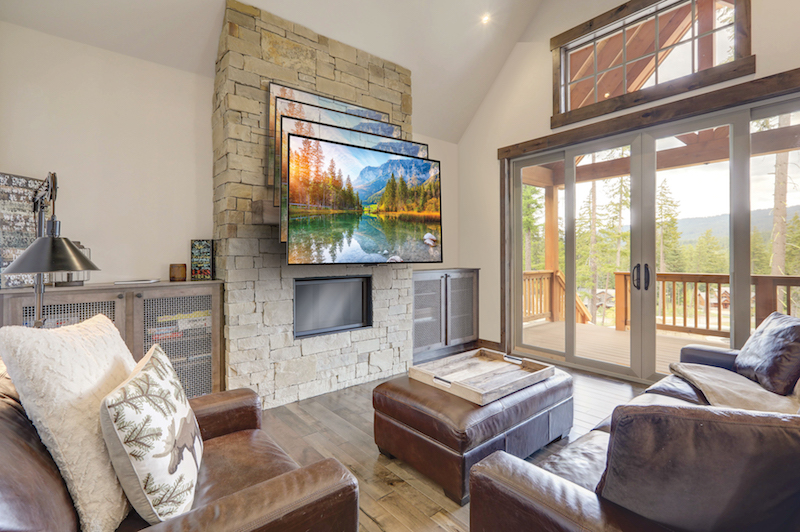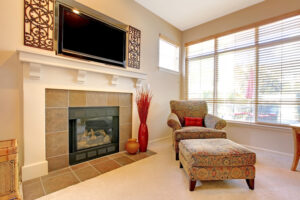For the longest time, conventional wisdom has been not to mount your TV above a fireplace. The bottom line is this: the reasons generally cited, while valid at one time, no longer hold water. This is a critical point because placing a TV above a fireplace has always been – and remains – an extremely popular mounting option. When you understand the reasons that this can be done cost-effectively, efficiently, and safely, you open up a new world of options for your TV placement.
The arguments boil down to three main categories: ergonomic, technical, and aesthetic.
The Ergonomic Argument: ‘It’s a Pain in the Neck’
This is probably the most frequently cited argument – and with good reason. If you’ve ever sat in the front row of a movie, you know the problem of watching a TV that is mounted too high on a wall. It requires you to crane your neck to see the screen, which can result in all kinds of health problems: neck and back pain, headaches, and eye strain, for starters. For those who try to avoid the sore-neck issue by using their eyes to look up instead of lifting their head, the problem of dry eyes comes into play as their eyes are forced to open wider. And the eye muscles get tired from working too hard as well.
Of course, you can slink down into the chair so you’re not bending your neck quite as much, but this unnatural posture is going to cause its own health issues. Not to mention angering your mother, who spent all those years yelling at you to sit up straight.
The ergonomic issue was comically driven home in a House Beautiful article: “The biggest reason I fall into the ‘anti-television-over-mantel’ camp is because it places the screen at an uncomfortable angle for viewing. You sit on the couch, looking very much like a crash test dummy in the second before an impact. That is no way to live.”
It’s universally agreed that optimal viewing, no matter the size of your screen, is straight on at eye level, both for ergonomic reasons as well as creating the most enjoyable TV-viewing experience; pulldown and swivel mounts can accomplish both objectives. By being able to lower your flat-panel television from above a mantel (or high on a wall) to eye level, you can create an ergonomically comfortable viewing position while optimizing viewing angle (more on that in a second). Plus, once your viewing is over, you can send the TV back to its original position.
There is a wide spectrum of mount types with varying features so remember to do your homework. But of prime importance are mounts that give you the most vertical distance to get as close to eye-level viewing as possible, as well as swivel capability so that your TV doesn’t hit or damage your mantel.
The Technical Issue: Looking for the ‘Sweet Spot’
Video experts agree that in addition to the health problems, there is the quality of the picture to consider. As stated on Build.com, “The impact [that] angle has on your TV picture will depend on the type of HDTV you are running. Image quality can be affected by both horizontal viewing angle (i.e., viewing the TV from either side), or vertical viewing angle (e.g., if your TV’s mounted too high or low).” The article also states that while newer video technologies have lessened the impact of viewing angle on picture quality, they have by no means eliminated it.
Consequently, if the viewer is not looking straight at the screen (and if the TV is mounted above a fireplace, they are not), the result can still be a washed-out image. Digital Trends notes that an LCD screen (which you find on “LED” TVs) is made up of numerous tiny, shuttered windows. These windows open and close to let the TV’s backlight through, thus creating an image. However, these windows have a minimum viewing angle; to be more specific, the screen has a sweet spot “cone” that shoots over the viewer’s head if the TV is too high, so the colors are not as vibrant when viewing off to the side (it’s even worse from below or above).
Again, a pulldown and swivel mount will alleviate this issue, bringing the TV to a level where the viewer is watching it straight on. Resolution and color clarity are greatly enhanced – much closer to the kind of picture you expected when you made the investment in a TV that would make you the envy of your friends and neighbors.
The Aesthetic Issue: The Center of Attention?
Many interior designers consider mounting a TV above the fireplace to be a major decorating faux pas. The primary reason mentioned is that the TV shouldn’t be the visual focus of the room. Those in the know often claim, somewhat condescendingly, that the television should be relegated to a separate room – not in the primary living area, which should be a “sanctum of conversation, introspection, and lively social intercourse.”
Some have gone so far as to insult the poor television. From House Beautiful: “Think of some of your favorite homes you’ve been in – ones where the decor really inspires you… and then, no doubt, they have the better part of an entire wall dedicated to… a large, shiny, glaringly unattractive black rectangle. Yes, the TV.” Wow, tell us what you really think.
Yet some of the most authoritative interior design voices disagree. An article in Better Homes and Gardens states, “Hanging a flat screen above a mantel or on a brick fireplace’s face results in a dual-purpose entertainment center that becomes a room’s visual centerpiece.”
What’s more, today’s TV’s are thinner, sleeker, and more visually striking than ever; they are virtual works of art – even when turned off. Consequently, there are many consumers who want to highlight these attractive electronic devices, not downplay them. And since they are so often mounted in the living room, consumers have grown accustomed to their presence – sometimes, they will express a note of envy at seeing the newest, biggest 8K OLED hanging like electronic royalty above a neighbor’s mantel.
And keep in mind: the space above the fireplace may very well be the only viable spot to mount your TV, depending on your home’s layout. Open floor plans have cut out entire walls, while built-in shelves and light sconces have frequently rendered alternative mounting locations moot.
Ultimately, it’s a matter of preference. There are those consumers who would prefer a TV-free living room. Conversely, some of us enjoy highlighting what we perceive to be an eye-catching, technological marvel. And still others have limited options of where their TV can reside. But for those who decide – out of necessity or choice – that an above-fireplace, living room TV is the way to go, the pulldown and swivel mount is a must-have device.
The Final Decision: There’s No Right or Wrong
As we’ve seen, the first two long-standing reasons not to hang a TV above the fireplace – ergonomics and picture clarity can be negated by the use of pulldown and swivel mounts. The third, personal preference, is just that – personal preference. And as noted, in some cases, it may be the only viable spot to put it. The insistence that it should be avoided at all costs is shortsighted and, to a large extent, doesn’t take into account the development of movable mounts, which solve at least two of the aforementioned problems. The bottom line is, there is no reason to summarily rule it out as an option.
Related: What MantelMount Hopes to Gain from Dynamic Mounting Acquisition








![ecobee premium airzone control The ecobee Smart Thermostat Premium. [Photo credit | ecobee]](https://restechtoday.com/wp-content/uploads/2025/06/ecobee-premium.jpg)
![Hub 3_02 The SwitchBot Hub 3 provides a user-friendly solution to the growing complexity of modern smart homes. [Photo credit | SwitchBot]](https://restechtoday.com/wp-content/uploads/2025/06/Hub-3_02-scaled-e1750179791687.png)
